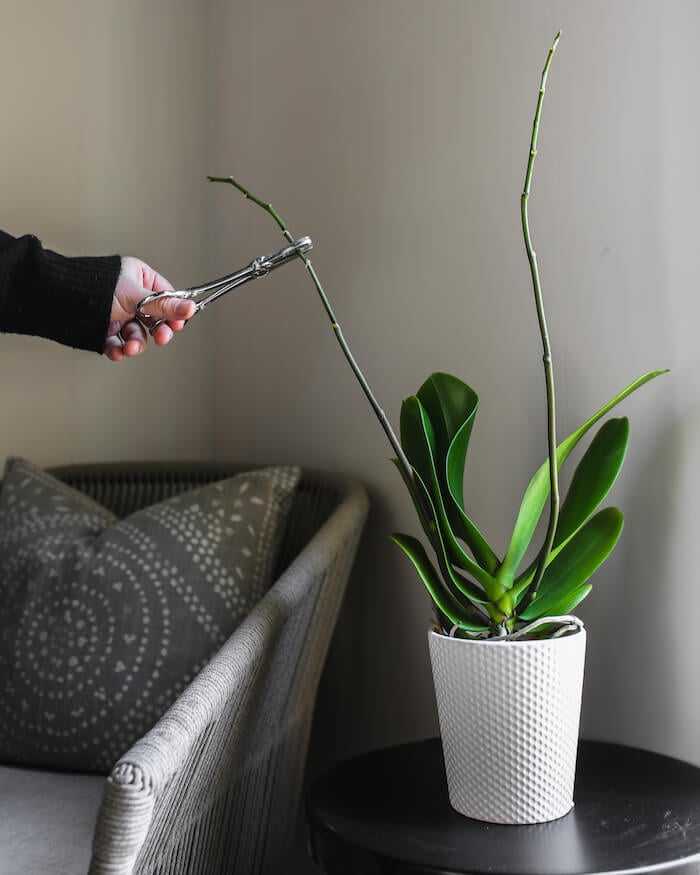
You brought home a beautiful orchid plant, only to drop something on it while cleaning. Or perhaps your playful dog knocked over the entire pot, resulting in broken leaves and stems. Does it have one root in the orchid grave? No!
Orchids have survived in the wild for a long time, so they're heartier than they appear. If you end up with broken leaves or stems, your orchid will continue to thrive with some basic orchid care and a few key techniques.
Unlike cut flowers, orchids add a touch of style to any environment while still attached to flower spikes, so we don’t usually think of cutting and displaying their flower stems. But cutting off and displaying a broken flower stem like you would a vase of flowers could be an option. Cut the damaged stem with a sterile knife or scissors above the break and put it in a vase with water—the stem will last one to two weeks in a vase.
A broken leaf shouldn’t be life-threatening to your Phalaenopsis orchid plant, but if you want to cut it off for display purposes, cut it a half-inch from the central stem with a sterile knife or scissors to prevent infection.
If one of the flowering stems is broken, you might be tempted to wrap some tape around it and hope nobody notices. They will. But there's a bigger problem: This invites infection, which can do serious damage to your orchid.
Instead, cut the orchid flower spike above the breaking point and put it in a vase with water like you would with any cut flower. Use a sterilized knife or scissors to prevent infection and be sure the base is even after you cut it so the plant can draw water up its stem.
We recommend putting cinnamon on the broken end for its antimicrobial properties. At this point, you have two good options: Encourage a secondary blooming or help your orchid shift into its vegetative cycle.
The advantage of this option is the swifter recovery for your orchid and increased chance to produce an entirely new flower spike sooner than it would otherwise!
Trim the bottom half of the broken stem back down to the base of the orchid using sharp, clean tools.
Pro Tip: If your flowering stem turns brown after being broken, this does not mean your plant is dying! Your plant is shifting to the vegetative cycle to focus on root and leaf growth as well as recovery as a reaction to the stressful experience of stem damage.
Secondary blooming occurs when your orchid reuses the same flowering stem to create a new set of blooms.
First, find the 'node,' a small scale-like section below the breakage point on your flowering stem. Trim the stem about a half inch above the node, making sure the cut is flat rather than angled.
Pro tip: An angled cut tells the orchid there is still a chance for continued growth from this point, so the plant will continue to send energy to the damaged point. A flat cut redirects growth, which is what we want.
A secondary blooming is never guaranteed even with the best care. New growth depends on your plant's genetics, energy stockpile, and care conditions.
If your orchid does decide to bloom from that location, you will notice new growth within a few weeks. It will take between one and three months for that new growth to produce buds.
Even the most careful orchid plant parents have had accidents resulting in torn leaves or broken stems. When the blooms fall, this isn't due to any past mistakes you've made. It's part of the orchid's lifecycle and it will likely bloom again as long as you practice good orchid care during its vegetative or dormant stage.
Watching your orchid lose its beautiful blooms is difficult, whether through an accident or as part of the orchid's natural cycle. Many orchid lovers have more than one orchid plant for this very reason. When the flowers fall on one plant, they bloom on another!
When your plant drops its blooms, it's time to trim the stem! This is the best way to care for your plant and encourage reblooming.
Over time, as your stem regrows, get a small stick, chopstick, or a floral stake and some floral tape or string, insert the stake about an inch into the potting media, and tape or tie the stem to the stake.

Copyright Just Add Ice® Orchids 2023